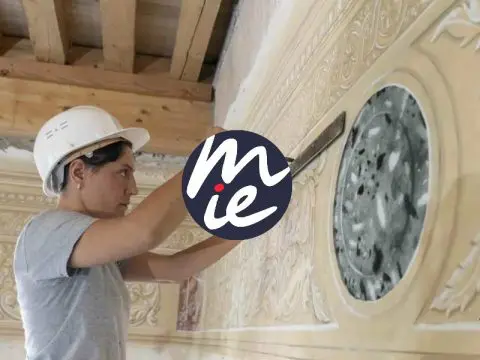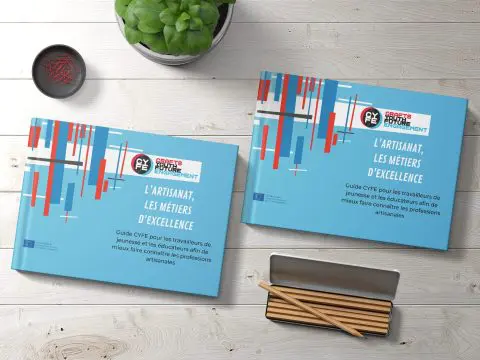You may observe some amazing gilded frames hanging on the walls of the room . Each frame has its own distinct motif, but the process of embellishing these objects is mostly the same despite the material or the decorative elements, it is an ancient technique that consists of applying a very thin layer of gold, known as “gold leaf”.
Gilding techniques date back to 2300 BC in Egypt, when royal goldsmiths first used a round stone to beat gold to create thin plates known as “gold foils.” Since gold is a durable and protective metal and was regarded as a symbol of immortality and divinity in Antiquity, tombstones of Pharaohs as well as priceless furniture and holy things were scrupulously covered with such precious foils. Shortly after, the Phoenicians and the Byzantines started gilding their statues and icons or using gilded tesserae to illuminate their mosaics in order to enhance the beauty of their works. Gilding, which originated in ancient Greece, Rome, and the Middle Ages, flourished throughout the succeeding ages and eventually became a widespread practise thanks to its various approaches.
Since its invention, the methods for creating gold leaves have rarely altered. The most stretchy and malleable metal is gold. Three kilometres might be covered by one gramme of gold. But, a small amount of silver and copper is added to gold to create a mixture that is roughly 96% gold in order to enhance the working qualities during the beating and make gold leaves even more flexible. Other craftspeople who need to improve their works, such as woodcarvers, cabinet makers, frame makers, bronzesmiths, glass makers, or even architects and designers, frequently collaborate closely with gilders. Gilders are skilled at working with a variety of materials, including metals, wood, leather, glass, ceramics, and even paintings.
The methods and materials used to prepare the surface prior to the application of the leaf are where professional gilders’ major methods diverge. The Détrempe, a water-based gilding, is only viable for interior objects or furniture and demands considerable technical knowledge and practical expertise, was given its name because it has a high proportion of water in the glue composition (often rabbit skin glue, chalk, and pigments). Water gilding, also known as gilding on bole, is mostly used for wood gilding and is based on the application of many sheets of gold on a layer of red clay (bole). The bole surface must be well prepared before the final burnishing in order to achieve a beautiful and smooth finish that will be warmed by the red reflections that the transparency of the gold will provide.
Gilding in the form of oil is used by professionals for less porous and outside surfaces, whereas water-based gilding is employed indoors to apply gold leaf on wood or other porous surfaces like plaster. Oil-based gold size will stick to a larger range of surfaces, such as metal, glass, and stone. Prior to applying the sizing, surfaces must either be non-porous or sealed with a coloured layer of paint. The undercoat’s colour will be apparent in transparency and repair any damage that atmospheric conditions have done to the gold leaf. A very thick glue made of linseed oil that has been heated at a very high temperature holds the gold leaves in place. This can be combined with resin to delay drying and make it easier to apply gold leaf comfortably. Once the glue has dried (experts refer to this as being “amoureuse”), it is ready to be covered with gold leaves. It takes around 12 hours to cure, although it is quicker and easier than water-based gilding. Nevertheless, surfaces cannot be burnished, and the appearance will be duller. Without expert application, the end product may lose transparency and resemble a painted surface.
No matter how ancient this craft is, restorers nowadays still use the same techniques to gild, such as Donatienne Lurquin (read an article about her ).
FÉLIX MOMMEN

Behind the piano, a bearded man is portrayed, he’s another important character in the story of this house. It’s Félix Mommen, an art supplies dealer, patron, and friend of many artists. He was a forerunner of the idea that artists need to be able to express themselves freely, therefore society has to support them from a materialistic point of view. His philosophy set the foundation of the “Ateliers Mommens” (in Saint Josse), where, from 1874 until 1894, two renowned architects, Ernest Hendrickx, and Henri Van Massenhove, built an ensemble of workshops. The workshops faced north, the best position in order to have a constant flow of light, but this building wasn’t only a place of creation: artists could also expose their artworks, and gather and share ideas. Given Mommen’s line of work, he made sure that they were always equipped with the best art supplies. Not very far from the Ateliers Mommen, lived our main character, H. Van Custem, who loved receiving avant-garde artists and he included many pieces of Mommen’s artists in his collection. Thanks to these two focal points, the neighbourhood buzzed with artists and intellectuals and it was known as ‘the little Montmartre of Brussels’.
After Mommen’s death in 1914, his son Joseph took over. Real estate speculation took its toll during the 80s on the Ateliers Mommen, forcing painters and sculptors to move. But all’s well what ends well, “la cité des artistes” has been saved and it is the oldest and last remaining artists’ colony in Brussels.












